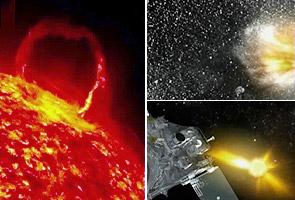 The Earth could be hit by a 'solar tsunami' anytime now as an unusually complex magnetic eruption on the Sun has flung a large cloud of electrically charged particles towards our planet, scientists have warned.
The Earth could be hit by a 'solar tsunami' anytime now as an unusually complex magnetic eruption on the Sun has flung a large cloud of electrically charged particles towards our planet, scientists have warned.
Several satellites, including NASA's new Solar Dynamics Observatory (SDO), recorded on Sunday a small solar flare erupting above sunspot 1092, the size of the Earth.
The satellites also recorded a large filament of cool gas stretching across the Sun's northern hemisphere also exploded into space.
The explosion, called a coronal mass ejection, was aimed directly towards Earth, which then sent a 'solar tsunami' racing 93 million miles across space, the New Scientist reported.
Read more at: http://www.ndtv.com/article/world/solar-tsunami-may-hit-earth-anytime-scientists-41912?cp
When the violent cloud hits, which could be anytime now, it could spark aurorae in the skies around the poles and pose a threat to satellites, although not a severe one, it said.
Despite being separated by hundreds of thousands of kilometres, the two events may be linked, said astronomers who studied the images from SDO that hint at a shock wave travelling from the flare into the filament.
"These are two distinct phenomena but they are obviously related," said Len Culhane, a solar physicist at the Mullard Space Science Laboratory, University College London.
Experts said the wave of supercharged gas will likely reach the Earth on Tuesday, when it will buffet the natural magnetic shield protecting Earth.
It is likely to spark spectacular displays of the aurora or northern and southern lights.
"This eruption is directed right at us," said Leon Golub, of the Harvard-Smithsonian Centre for Astrophysics.
"It's the first major Earth-directed eruption in quite some time," Golub was quoted as saying by the Telegraph.
Scientists recently discussed the implications of volatile space weather at the Space Weather Enterprise Forum. One of the biggest concerns is the potential for a major blackout.
Daniel Baker, Space Scientist, University of Colorado-Boulder says, " One of the that things we really saw the major impacts would be on the power grid. That a major storm could cause immense damage. It could cause major blackouts that could last for weeks, possibly months or even years."
In August 2003 a computer malfunction played a major role in the US's worst blackout putting 50 million people in the dark, including all of New York City.
The effects of a solar storm on the power grid are still unknown, but researchers are trying to assure they are prepared for the worst case scenarios.
Richard Fisher, head of NASA's Heliophysics Division says, "Hours is okay, you can get along. A few people stuck in elevators, a few people on heart-lung machine, it's very important for them. As you go into days our water supplies are impacted. And that's an essence of life. So it's potentially a devastating blow. But we think it's an unlikely blow."
NASA recently warned that Britain could face widespread power blackouts as well and be left without critical communication signals for long periods of time, after the earth is hit by a once-in-a-generation 'space storm'.
Earlier scientists had said that they believed the Earth would be hit with unprecedented levels of magnetic energy from solar flares after the Sun wakes "from a deep slumber" sometime around 2013.
It remains unclear, however, how much damage this latest eruption will cause the world's communication tools.
Dr Lucie Green, of the Mullard Space Science Laboratory, Surrey, who followed the flare-ups using Japan's orbiting Hinode telescope, said this was a very rare event.
"Not one, but two almost simultaneous eruptions from different locations on the Sun were launched toward the Earth.
"These eruptions occur when immense magnetic structures in the solar atmosphere lose their stability and can no longer be held down by the Sun's huge gravitational pull. Just like a coiled spring suddenly being released, they erupt into space."
"This means we have a very good chance of seeing major and prolonged effects, such as the northern lights at low latitudes."
So how should individuals prepare for solar storms?
Richard Fisher says, "I think a little bit of extra water, a couple of flashlights, and a transistor radio are a few good things to have."
Scientists are preparing, too.
NASA, the Department of Defense, and the Federal Aviation Administration - are working together to prepare for space weather events, and will soon be launching probes to monitor radiation belts.
0 comments:
Post a Comment